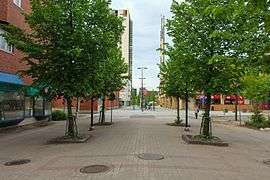Leppävaara
Leppävaara (Swedish: Alberga) is a district of Espoo, a city in Finland. The Rantarata rail line and the Ring Road I, the busiest road in Finland, cross in Leppävaara, thus making it a major traffic hub in the Greater Helsinki region. The Sello Shopping Centre is also located in Leppävaara.
Leppävaara Alberga | |
|---|---|
 Location of Leppävaara (red) within Espoo (light green) and Suur-Leppävaara (dark green) | |
| Coordinates: 60°13′N 24°49′E | |
| Country | |
| Region | |
| Sub-region | Greater Helsinki |
| Municipality | |
| Main District | Suur-Leppävaara |
| Inner District(s) | Pohjois-Leppävaara, Etelä-Leppävaara, Mäkkylä, Lintukorpi, Lintulaakso, Uusmäki, Lintumetsä, Perkkaa |
| Area | |
| • Total | 6.4 km2 (2.5 sq mi) |
| Population (31.12.2018) | |
| • Total | 32,095 |
| • Density | 5,000/km2 (13,000/sq mi) |
| Languages | |
| • Finnish | 87.6 % |
| • Swedish | 4.2 % |
| • Other | 8.2 % |
| Postal Code(s) | 02600, 02650 |
| Jobs | 10,398 |
History

The old manor houses of Alberga and Leppävaara are located in Leppävaara. Located nearby is also the manor house of Kilo.
After the railway line from Helsinki to Turku was completed in 1903 Leppävaara began to develop as a manor neighborhood. The bulk of the settlement was on the northern side of the railway and the southern side remained mostly in agricultural use. Krepost Sveaborg, a WW1-era fortification system of trenches and artillery batteries defending Helsinki passes through Leppävaara. Though some of them are destroyed, there are still a lot of trenches and bunkers in the area, mainly in Vallikallio and Mäkkylänmetsä.
Leppävaara was formed as a community in 1921 and it remained such until all such ones at the beginning of 1956 were abolished. In the early 1960s as well as the separating also of Leppävaara, Tapiola from Espoo was designed as a town but the plans were rejected when Espoo at the beginning of 1963 was formed on the whole as a town.
In Eliel Saarinen's 1915 "Suur-Helsinki" plan the architect proposed considerably large scale buildings around the station of Leppävaara. The area however remained mostly unbuilt until the 1980s, when urban development began on the area north of the railway line. The area on the southern side of the railway however stayed in agricultural use until the turn of the millennia, but is now a very urban neighborhood. The planning of the area was slowed especially by the disagreements between the municipalities of Helsinki and Espoo as a large part of the area was for a long time in the possession of the city of Helsinki even though it was located inside the borders of Espoo.
Maxi-Market, the first hypermarket in Finland, was built in Leppävaara by Rake Oy and Osuusliike Elanto and was opened on November 4, 1971. The building was designed by Toivo Korhonen architect office and it was 130 metres long, 80 metres wide and had a total floor area of 15 800 square meters. The building was demolished in 2003 to make space for the new Sello shopping centre.
